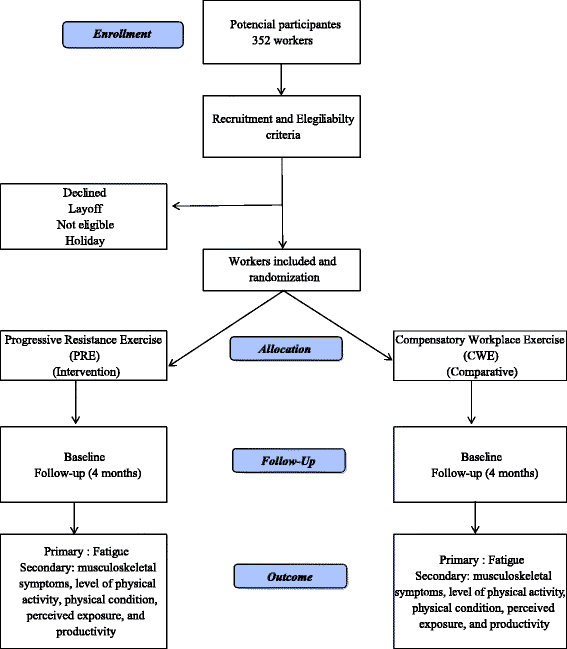Resistance training program for fatigue management in the workplace: exercise protocol in a cluster randomized controlled trial
- PMID: 28003034
- PMCID: PMC5178090
- DOI: 10.1186/s12889-016-3872-5
Resistance training program for fatigue management in the workplace: exercise protocol in a cluster randomized controlled trial
Abstract
Background: Fatigue is a multifactorial condition that leads to disease and loss in production, and it affects a large number of workers worldwide. This study aims to demonstrate a resistance exercise protocol that individuals will perform during the work schedule, and to evaluate the effectiveness of this exercises program for fatigue control.
Methods/design: This is a cluster randomized controlled trial with two arms and is assessor blinded. A total of 352 workers of both sexes, aged 18-65 years, from a medium-sized dairy plant were enrolled in this study. Participants will be recruited from 13 production sectors according to the eligibility criteria and will be randomized by clusters to either the Progressive Resistance Exercise (PRE) intervention group or the Compensatory Workplace Exercise (CWE) comparative group. A resistance exercise program will be implemented for both groups. The groups will receive instructions on self-management, breaks, adjustments to workstations, and the benefits of physical exercise. The PRE group will perform resistance exercises with gradual loads in an exercise room, and the CWE group will perform exercise at their workstations using elastic bands. The exercise sessions will be held 3 times a week for 20 min. The primary outcome measures will be symptoms of physical and mental fatigue, and muscular fatigue based on a one-repetition maximum (1RM). The secondary outcome measures will be level of physical activity, musculoskeletal symptoms, physical condition, perceived exposure, and productivity. The workers will be assessed at baseline and after a 4-month program. A linear mixed model will be applied on an intention-to-treat basis.
Discussion: This intervention is expected to reduce symptoms of fatigue in the workers. The exercise program is indicating in the workplace, although there are few studies describing the effects of exercise on the control of fatigue in the workplace. Emphasis will be placed on adherence to the program, which may result in significant and clinically important reductions in fatigue. It is also expected that the findings of this study will contribute significantly to the decision-making capacity of professionals working in the field of occupational health.
Trial registration: U.S. National Institutes of Health, ClinicalTrials.gov Identifier: NCT02172053 . Date registered 19 June 2014.
Keywords: Fatigue; Industrial workers; Physical Therapy; Resistance Exercise.
Figures
References
Publication types
MeSH terms
Associated data
LinkOut - more resources
Full Text Sources
Other Literature Sources
Medical


